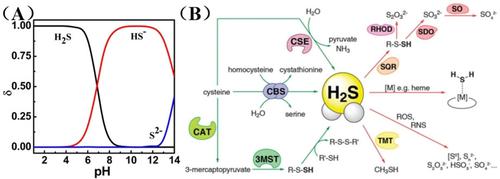当前位置:
X-MOL 学术
›
Electroanalysis
›
论文详情
Our official English website, www.x-mol.net, welcomes your
feedback! (Note: you will need to create a separate account there.)
In Vivo Detection of Hydrogen Sulfide in Brain and Cell
Electroanalysis ( IF 2.7 ) Pub Date : 2021-09-01 , DOI: 10.1002/elan.202100399 Shuwen Cheng 1 , Li Zhang 1 , Meining Zhang 1
Electroanalysis ( IF 2.7 ) Pub Date : 2021-09-01 , DOI: 10.1002/elan.202100399 Shuwen Cheng 1 , Li Zhang 1 , Meining Zhang 1
Affiliation

|
Hydrogen sulfide (H2S), is proposed as a cytoprotectant and gasotransmitter, involving in many physiological processes and regulating of some diseases. In addition, H2S is a small molecular with a minimum of steric hindrance compared with other reactive sulfur species. In physiological atmosphere, H2S is mainly existent in HS−, which has a strong nucleophilicity and reducing potency. It also can precipitate with some metal ions forming metallic sulfides with high precipitation coefficient. In recent years, the researchers have a desire to develop methods to achieve real-time detection of H2S in vivo, further understanding the physiology and pathology of H2S. In this minireview, we summarize recent progress for detecting of H2S in brain or cell and briefly expound the principle of methods with the comparison of the different methods between performance and temporal resolution.
中文翻译:

脑和细胞中硫化氢的体内检测
硫化氢(H 2 S)被认为是一种细胞保护剂和气体递质,参与许多生理过程和调节某些疾病。此外,H 2 S 是一种小分子,与其他活性硫物质相比,空间位阻最小。在生理气氛中,H 2 S主要存在于HS -中,具有很强的亲核性和还原性。它还可以与一些金属离子沉淀形成具有高沉淀系数的金属硫化物。近年来,研究人员渴望开发一种方法,实现对体内H 2 S的实时检测,进一步了解H 2的生理和病理。S. 在这篇综述中,我们总结了脑或细胞中 H 2 S 检测的最新进展,并简要说明了方法的原理,并比较了不同方法在性能和时间分辨率方面的比较。
更新日期:2021-09-01
中文翻译:

脑和细胞中硫化氢的体内检测
硫化氢(H 2 S)被认为是一种细胞保护剂和气体递质,参与许多生理过程和调节某些疾病。此外,H 2 S 是一种小分子,与其他活性硫物质相比,空间位阻最小。在生理气氛中,H 2 S主要存在于HS -中,具有很强的亲核性和还原性。它还可以与一些金属离子沉淀形成具有高沉淀系数的金属硫化物。近年来,研究人员渴望开发一种方法,实现对体内H 2 S的实时检测,进一步了解H 2的生理和病理。S. 在这篇综述中,我们总结了脑或细胞中 H 2 S 检测的最新进展,并简要说明了方法的原理,并比较了不同方法在性能和时间分辨率方面的比较。











































 京公网安备 11010802027423号
京公网安备 11010802027423号